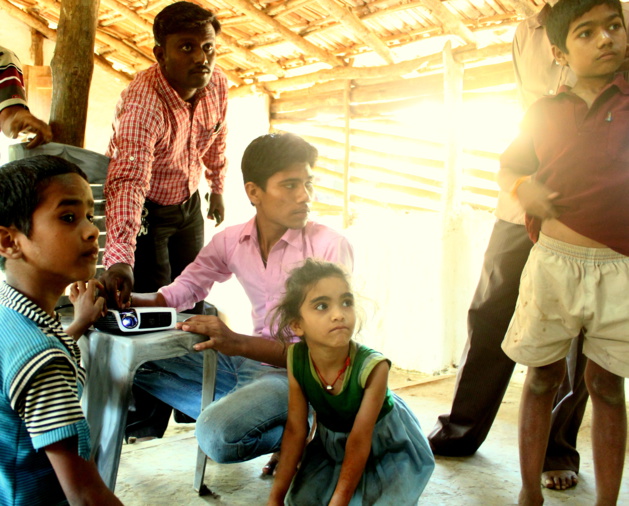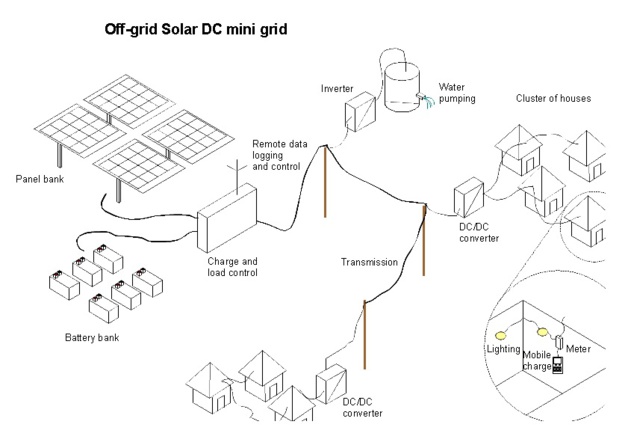
Overhead projector working thanks to solar power, in a rural area's school where electricity's access is hard.
According to the Indian government, today, 94% of individuals can access the electrical network in cities. On the other hand, only 67% of those in rural areas has this access. No fewer than 300 million people, that is to say one quarter of the Indian population, are still deprived of electricity in this country. In response to this situation, Indian companies have undertaken the setup of systems of renewable energy production in rural areas. These solutions have the advantage of suiting very well to geographical as far as economical local realities. Above all, they are part of the economic and social development of rural India especially promoting children’s education. These initiatives illustrate well the possibilities that the renewable energies give in a sustainable development prospect.
Restricted electricity's access consequences
Gaining access to electricity is a difficult task for Indian countries. To begin, the kilowatt-hour's price is rather high compared to the the cost of living: 6 euros per kWh (according to the EIA) for a GDP per capita of € 1,300 in India (according to the World Bank) against 14euros per kWh for a GDP per capita of € 36,000 in France. So electricity is a relatively expensive utility. When there is an electrical connection in villages it is often defective and causes frequent power cuts, in particular during a bad weather or spikes in consumption. In addition, sometimes a tree felled by storms can result in the breaking of a power cord, requiring the intervention of a technical team that could take several days to fix it.
When a village can't access electricity, it often means the distance is insufficient. The distance from the production centers implies considerable losses in line as the connection is concerned, and difficulties to access a village in the heights induce installation costs that systematically are considered to be prohibitive.
Electrical needs in those towns often are only essential : mainly about lighting, they usually represent a few watts per home. But consequences of the lack of lighting are important. In a lot of villages, it already is dark when children come back from school. Kerosene lamps can permit them to do their homework, but they also need to be allowed to use it. Above all, the needed kerosene to make the lamp work is expensive, which is what usually prevents them from reading for pleasure. So, the lack of electricity stands the way of the education of those children.
Renewable energy, an efficient solution
Production systems for renewable energy are a solution to issue of electrical access in rural areas. As they don't need combustible or electrical connections; they are absolutely self-sustainable and have several other advantages. The example of Senthil and Deepti Kumar, the parents of three children and tea farmers in a plantation in Southern India, illustrates this so well. They live in a small village called Ramachandrapura in the heights, at 70 km from the first city accessing the electrical network. Until, then, they spent 80 rupees per month, or 1 euro in petrol for p kerosene lamps and they did so for a restricted use and Spartan lighting to improve their comfort of living, they wished to subscribe to a lighting contract including three low energy lamps for an electrical charge equal to 3 watts per lamp.
So the Kumar family faced two options. The first one, the Solar Home System, is a self-sustainable solar kit containing a lamp, a solar panel and a battery in order to ensure a quite some self-sustainability and permits light at nighttime. The panel is fastened on the roof and it is a done deal : Home is energetically independent. The second option, the Solar Mini-Grid is a centralized solar mini-network. All the solar panels are installed on the sunniest roof of the village then they redistribute the electricity, supplying lighting in this way to the various subscribers.
The second model of electricity sharing is more flexible as energy is concerned, but also takes longer to implement. In reality, both systems provide benefits and drawbacks depending on each village's specificities : geographical location, social condition or even the number of subscribers. For example, if several homes in the village wish to have their disposal solar lighting and if the social cohesion is good, it would be preferable to choose the electricity sharing option, the Solar Mini-Grid. This is the most efficient solution in energetical management : if one home uses more electricity than what they planned, they can draw off the neighbor's one. About the Solar Home System, it is of interest for the self-sustainability and for the quickness of the installation : besides, Senthil and Deepti preferred this option. In both cases, solar source lighting has the huge advantage of delivering free energy.

Having said that, those systems have limits too. It requires to recognize that a solar production system can't guarantee a fully ecological life cycle, even if it is more than production systems for heat energy. The battery's lifetime is bound to six or seven years, is hardly recyclable and, in India, solar panel recycling is not systematic yet. But, the most important obstacle to resorting to these systems of renewable energy in the rural environments is the initial investment. For the Kumar family, it costs just under 20 euros for their three lamps system, but for a country where the major part of wage is spent on food, it represents a lot. Fortunately, there are solutions, such as the microcredit. Microcredit companies, numerous in this country, offer for example a two-year loan at 17% fixed-rate : so, in just two years, Senthil and Deepti will have paid the loan back, paying each month the same sum of money as what they spent for the kerosene of their lamp, that is to say 80 rupees. Then, they will access lighting for free.
High performance and responsible Indian companies
Today, various initiatives have been led in India in renewable energy field. Other systems, such as wind turbines, the small hydraulic systems called “pico-hydro” or biomasses systems, are suitable for those decentralized areas. Nevertheless, it is necessary to differentiate small-scale production systems – installed in a village, a school or directly intended to private individuals, that are of the order of the watt or the kilowatt – from the large-scale systems of renewable energy production, that are, as in North-Eastern India, electrically connected to the national network. The first ones are made to make decentralized areas self-sustainable and energetically independent. The latter aims at producing electricity for the national network while decreasing the environmental impact. Both problematics are rather different. For the major projects, companies in charge of the installation are considerable or international Indian companies. On the other hand, the ones operating in rural areas are generally smaller.
Often, those companies are truly committed to improving the living conditions of the rural populations based on renewable energies. The main stake they have to face lies in their capability to keep a relationship of proximity between fitters and users, in order to ensure the proper functionality and the maintenance of the production of equipment of renewable energies.
To remedy this, the Selco India company, expert in solar installations, offers closeness to its users, thanks to the forty or so sectors mainly divided through the State of Karnataka and making up sales, installation and maintenance centers. The company also gives a particular importance to relationships of trust between customers and suppliers, as the founder's sentiments well illustrate it.
“From my own experience, a collaboration with a supplier only works if you go beyond the ordinary professional relationship. We must include our partners in our activities, invite them to strategy meetings, and this should not be boiled down to ordinary transactions. Thanks to this, news a day, former bank partners, now retired, or well-known figures as the former CEO of the TATA BP company still call us asking about the progress and advances of our actions. Establishing this kind of relation takes time. This is only my opinion, mere professionalism is not enough to work, especially in our sector” Harish Hande, founder and director of Selco India explains.
Resorting to renewable energies now is an efficient solution to give no urban populations a better access to electricity. For the Kumar family, the advantages of those ecosystems of energy production are revealed to be many: economical profits, of course, but also a better battery life, a higher quality of living, and the possibility for their children to get educated at night. Sustainable development thanks to renewable energies is not a myth. Local actors have invested for a long while in this sector and have already proven the potential of these solutions to improve the living conditions of rural Indian people.





























